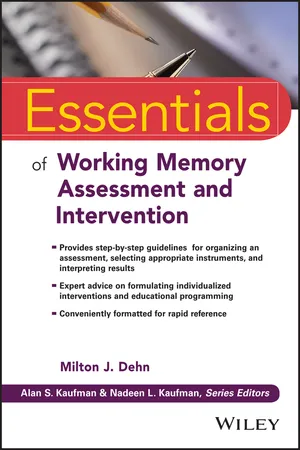
Essentials of Working Memory Assessment and Intervention
- English
- ePUB (mobile friendly)
- Available on iOS & Android
Essentials of Working Memory Assessment and Intervention
About This Book
Improve academic learning outcomes with accurate working memory assessment and evidence-based interventions
Essentials of Working Memory Assessment and Intervention is an accessible, practical guide to accurately and efficiently assessing working memory. This comprehensive resource explains the theories of working memory, with an emphasis on cognitive load theory, and provides step-by-step guidelines for organizing a cross-battery assessment, selecting appropriate instruments, interpreting results, and formulating individualized interventions and educational programming. In-depth case studies illustrate typical profiles found in children and adolescents with working memory deficits, and the companion CD features worksheets, testing charts, and other useful resources. Reader-friendly design elements including Rapid Reference, Caution, and Don't Forget boxes, and practice questions, bullet points, and icons make this guide useful for both study and desk reference.
Working memory deficits are the main reason why students with disabilities are unable to successfully respond to regular education interventions. Given the strong relationship between working memory and all areas of academic learning, a deeper understanding of working memory and the related assessments and interventions can facilitate greater achievement. This book helps readers:
- Understand the development and neuroanatomy of working memory
- Learn techniques for improving working memory in the classroom
- Examine strategies for brain-based working memory training
- Effectively utilize working memory assessment measures
By examining the critical functions of working memory and its relationship with specific learning disabilities, then providing strategies for assessment and detailed intervention guidance, this book helps educatorsand professionals guide their students and clients toward improved cognitive functioning, reduced frustration, and improved academic performance. For those seeking a practical approach to working memory, Essentials of Working Memory Assessment and Intervention provides the tools and information they need.
Frequently asked questions
Information
Chapter One
Working Memory Models
Don't Forget
Caution
Working Memory's Influence
- Keeping up with the flow of a conversation and remembering what one was going to say.
- Noticing errors that are contained in a written sentence one just produced.
- Keeping track of one's place while counting.
- Being able to take detailed notes while listening at the same time.
- Remembering multistep directions that were just presented or read.
- Completing a task in a time-efficient manner.
- Coping with distractions while thinking.
- Comprehending what is being said or read.
- Remembering what one was going to do next.
- Keeping track of subproducts while doing mental arithmetic.
- Being able to switch between mental tasks.
- Being able to reason, such as comparing and contrasting two concepts.
- Integrating visual and auditory information.
- Efficiently memorizing information.
- Consciously retrieving a name or word that does not come immediately.
Baddeley's Working Memory Model
Rapid Reference 1.1 Baddeley's Working Memory Model

The Phonological Loop
The Visuospatial Sketchpad
Table of contents
- Cover
- Title Page
- Copyright
- Table of Contents
- Dedication
- Series Preface
- Acknowledgments
- Chapter One: Working Memory Models
- Chapter Two: Cognitive Processes Highly Related With Working Memory
- Chapter Three: Development, Neuroanatomy, and Risk Factors
- Chapter Four: Working Memory's Influence on Academic Learning and Performance
- Chapter Five: Assessment Strategies
- Chapter Six: Psychological Scales That Measure Working Memory
- Chapter Seven: Working Memory Interventions That Change the Brain
- Chapter Eight: Supporting Working Memory in the Classroom
- Chapter Nine: Case Study
- Appendix A: Scaled Score to Standard Score Conversion Table With Percentiles
- Appendix B: T-Score to Standard Score Conversion Table
- Appendix C: Working Memory Composites and Subtests Sorted by Scale
- Annotated Bibliography
- References
- About the Author
- About the Online Resources
- Index
- End User License Agreement